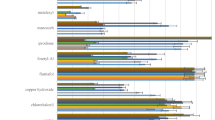Abstract
Thiabendazole (TBZ) and pentachloronitrobenzene (PCNB) alone and in combination were laboratory, greenhouse, and field tested during a five-year period (1977-1982) for their effectiveness in reducing incidence and severity of damage caused byRhizoctonia solani to white potato (Solarium tuberosum). Growth ofR. solani on amended potato dextrose agar was prevented at 7 ppm TBZ and 80,000 ppm PCNB. Tuber-borne sclerotial germination and hyphal growth were prevented following seed treatment with 6,000 ppm TBZ, and severely inhibited by combination treatments of 12,500 or 50,000 ppm PCNB and 1,500 ppm TBZ. Seed treatments which provided the most effective field control ofR. solani were combinations of PCNB (50,000, 25,000 ppm) and TBZ (1,500 ppm), followed by TBZ alone (6,000 ppm) and PCNB alone at rates of 50,000 ppm or above.
Resumen
El tiabendazole (TBZ) y el pentacloronitrobenceno (PCNB) solos o combinados fueron sometidos a prueba de laboratorio, invernadero y campo durante un periodo de cinco años (1977-1982) respecto a su efectividad en reducir la incidencia y la severidad del daño causado porRhizoctonia solani en la papa blanca (Solanum tuberosum). Se previno el crecimiento deR. solani en papa dextrosa agar modificado con 7 ppm de TBZ y 80 000 ppm de PCNB. La germinación de esclerotes originados en los tubérculos y el crecimiento de hifas fueron prevenidos después de un tratamiento de la semilla con 6 000 ppm de TBZ y severamente inhibidos por tratamientos de combinaciones de 12 500 ó 50 000 ppm de PCNB y 1 500 ppm de TBZ. Los tratamientos de la semilla que proporcionaron el más efectivo control de campo, fueron combinaciones de PCNB (50 000, 25 000 ppm) y TBZ (1 500 ppm) seguidas por TBZ solo (6 000) y PCNB solo a dosis de 50 000 ppm ó más.
Similar content being viewed by others
Literature cited
Anonymous. On the control ofRhizoctonia solani in seed potato cultivation in the Netherlands.
Blaszczak, W., Z. Weber, E. Glebczynski and L. Kulczak. 1978. Control of the potato black scurf (Rhizoctonia solani) by chemical treatment of seed tubers. Polish Agric Ann 8: 101–114.
Bolkan, H.A. 1976. Seed tuber treatment for the control of black scurf disease of potatoes. NZJ Exp Agric 4:357–361.
Cetas, R.C., 1970. Evaluation of fungicides as seed piece treatments for the control of Fusarium seed piece decay, Rhizoctonia disease and scab of potatoes in 1970. Mimeographed Report No. 1:1–13.
Dana, B.F. 1925. The Rhizoctonia disease of potatoes. Wash Agric Expt Sta Bull 191:1–78.
Copeland, R., C. Logan and C. Little. 1980. Fungicidal control of potato black scurf. Sup Ann Appl Biol 94:No. 1:36–37.
Dutt, B.L. and P. Thaplyal. 1978. Laboratory evaluation of efficacy of chemical treatment of seed potatoes for control of black scurf caused byRhizoctonia solani. J Indian Potato Assn 5:167–169.
Frank, J.A. 1981. Rhizoctonia canker (black scurf).In: Compendium of Potato Diseases. Hooker, W.J., ed. Am Phytopathol Soc 52–54 pp.
Frank, J.A. and S.S. Leach. 1980. Comparison of tuber-borne and soil-borne inoculum in the Rhizoctonia disease of potato. Phytopathology 70:51–58.
Frank, J.A., S.S. Leach and R.E. Webb. 1976. Evaluation of potato clone reaction toRhizoctonia solani.Plant Dis Rep 60:910–912.
Humphreys-Jones, D.R. 1977. Fungicidal treatment of seed potato clone reaction of stem cankerRhizoctonia solani.In: British Crop Protection Conference Proceedings 2:485–490.
Leach, S.S. 1984. Unpublished research.
Leach, S.S. and L.W. Nielsen. 1975. Elimination of fusarial contamination on seed potatoes. Am Potato J 52:211–218.14.
Morse, W.J. and M. Shapovalov. 1914. The Rhizoctonia disease of potatoes. Maine Agric Exp Stn Bull 230:193–217.
Small, T. 1943. Black scurf and stem canker (Corticium solani Bound and Galz). Ann Appl Biol 30:221–226.
Stachiwicz, H., L. Adam and U. Albrecht. 1978. Possibilities for chemical control ofRhizoctonia solani Kuhn on potatoes. Nachrichtenblat fur de Pflanzenschutz in der DDR 32:208–212.
Van Emden, J.H. 1965.Rhizoctonia solani: Results of recent experiments. Eur Potato J 8:188–189.
Weinhold, A.R. and T. Bowman. 1982. Rhizoctonia disease of potato: Effect on yield and control by seed tuber treatment. Plant Dis 66:815–818.
Whenham, H.T., B.L. MacKintosh and H.A. Bolkan. 1976. Evaluation of fungicides for control of potato black scurf disease. NZJ Exp Agric 4:97–100.
Author information
Authors and Affiliations
Additional information
Reference to a specific brand or firm name does not constitute endorsement by the U.S. Department of Agriculture over others of a similar nature not mentioned.
Rights and permissions
About this article
Cite this article
Leach, S.S., Murdoch, C.W. Evaluation of thiabendazole and pentachloronitrobenzene for control of the Rhizoctonia disease complex on white potato (Solanum tuberosum L.). American Potato Journal 62, 459–469 (1985). https://doi.org/10.1007/BF02854519
Accepted:
Issue Date:
DOI: https://doi.org/10.1007/BF02854519




